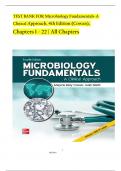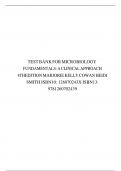TEST BANK FOR Microbiology Fundamentals-A
Clinical Approach, 4th Edition (Cowan),
Chapters 1 - 22 | All Chapters
1
McGraw
, 2
McGraw
,Microbiology Fundamentals: A Clinical Approach, 4e (Cowan)
Chapter 1 Introduction to Microbes and Their Building Blocks
1) When humans manipulate the genes of microorganisms, the process is called .
A) bioremediation
B) genetic engineering
C) epidemiology
D) immunology
E) taxonomy
ANSWER: B
Section: 01.01
Topic: Microbial Roles; Basics of Genetic Engineering
Bloom's: 01. Remember
ASM Topic: Module 04 Information Flow
ASM Objective: 04.05 Cell genomes can be manipulated to alter cell function.
2) Which of the following is not considered a microorganism?
A) Mosquito
B) Protozoan
C) Bacterium
D) Virus
E) Fungus
ANSWER: A
Section: 01.01
Topic: Taxonomy of
MicroorganismsBloom's: 01.
Remember
ASM Topic: Module 01 Evolution
ASM Objective: 01.02 Mutations and horizontal gene transfer, along with the immense variety
ofmicroenvironments, have resulted in a vast diversity of microorganisms.
3) All microorganisms are best defined as organisms that .
A) cause human disease
B) lack a cell nucleus
C) are infectious particles
D) are too small to be seen with the unaided eye
E) can only be found growing in laboratories
3
McGraw
,ANSWER: D
Section: 01.01
Topic: Microbial Roles
Bloom's: 01. Remember
ASM Topic: Module 01 Evolution
ASM Objective: 01.02 Mutations and horizontal gene transfer, along with the immense
variety ofmicroenvironments, have resulted in a vast diversity of microorganisms.
4
McGraw
,4) Which activity is an example of biotechnology?
A) Bacteria in the soil secreting an antibiotic to kill competitors
B) A microbiologist using the microscope to study bacteria
C) Egyptians using moldy bread on wounds
D) Escherichia coli producing human insulin
E) Public health officials monitoring diseases in a community
ANSWER: D
Section: 01.01
Topic: Basics of Genetic
EngineeringBloom's: 02.
Understand
ASM Topic: Module 06 Impact of Microorganisms
ASM Objective: 06.03 Humans utilize and harness microorganisms and their products.
5) Living things ordinarily too small to be seen with the unaided eye are termed .
A) bacteria
B) viruses
C) parasites
D) microorganisms
E) prokaryotes
ANSWER: D
Section: 01.01
Topic: Cellular
OrganizationBloom's: 01.
Remember
ASM Topic: Module 01 Evolution
ASM Objective: 01.02 Mutations and horizontal gene transfer, along with the immense variety
ofmicroenvironments, have resulted in a vast diversity of microorganisms.
6) The microorganisms that recycle nutrients by breaking down dead matter and wastes are
called
.
A) decomposers
B) prokaryotes
C) pathogens
D) eukaryotes
E) fermenters
ANSWER: A
Section: 01.01
Topic: Microbial Roles
Bloom's: 01. Remember
ASM Topic: Module 06 Impact of Microorganisms
ASM Objective: 06.01 Microbes are essential for life, as we know it, and the processes that
support life (e.g. in biogeochemical cycles and plant/animal microflora).
5
McGraw
,7) Cells, like bacteria and archaea, that do not have a nucleus in their cells have traditionally
beencalled .
A) decomposers
B) prokaryotes
C) pathogens
D) eukaryotes
E) fermenters
ANSWER: B
Section: 01.01
Topic: Cellular
OrganizationBloom's: 01.
Remember
ASM Topic: Module 02 Structure and Function
ASM Objective: 01.01 Cells, organelles (e.g. mitochondria and chloroplasts) and all major
metabolic pathways evolved from early prokaryotic cells.
8) The first cells appeared about billion years
ago.A) 5.2
B) 4.6
C) 3.8
D) 2.9
E) 1.5
ANSWER: C
Section: 01.01
Topic: History of Microbiology
Bloom's: 01. Remember
ASM Topic: Module 01 Evolution
ASM Objective: 01.01 Cells, organelles (e.g. mitochondria and chloroplasts) and all major
metabolic pathways evolved from early prokaryotic cells.
9) Which of the following is not a human use of microorganisms?
A) Making bread
B) Treating water and sewage
C) Manufacturing copper wire
D) Mass producing antibiotics
E) Cleaning up oil spills
ANSWER: C
Section: 01.01
Topic: Microbial Roles
Bloom's: 01. Remember
ASM Topic: Module 06 Impact of Microorganisms
ASM Objective: 06.03 Humans utilize and harness microorganisms and their products.
6
McGraw
,10) Using microbes to detoxify a site contaminated with heavy metals is an example of .
A) biotechnology
B) bioremediation
C) decomposition
D) immunology
E) epidemiology
ANSWER: B
Section: 01.01
Topic: Microbial Roles
Bloom's: 01. Remember
ASM Topic: Module 06 Impact of Microorganisms
ASM Objective: 06.03 Humans utilize and harness microorganisms and their products.
11) Disease-causing microorganisms are called .
A) decomposers
B) prokaryotes
C) pathogens
D) eukaryotes
E) fermenters
ANSWER: C
Section: 01.01
Topic: Microbial Roles
Bloom's: 01. Remember
ASM Topic: Module 06 Impact of Microorganisms
ASM Objective: 05.04 Microorganisms, cellular and viral, interact with both human
andnon-human hosts in beneficial, neutral or detrimental ways.
12) The most prevalent worldwide infectious diseases are .
A) AIDS-related diseases
B) diarrheal diseases
C) malaria diseases
D) measles
E) respiratory diseases
ANSWER: E
Section: 01.01
Topic: Microbial Roles
Bloom's: 01. Remember
ASM Topic: Module 06 Impact of Microorganisms
ASM Objective: 05.04 Microorganisms, cellular and viral, interact with both human
andnon-human hosts in beneficial, neutral or detrimental ways.
7
McGraw
,13) Which of the following is a unique characteristic of viruses that distinguishes them
from theother major groups of microorganisms?
A) Cause human disease
B) Lack a nucleus
C) Cannot be seen without a microscope
D) Contain genetic material
E) Lack cell structure
ANSWER: E
Section: 01.01
Topic: General Viral Properties
Bloom's: 01. Remember
ASM Topic: Module 02 Structure and Function
ASM Objective: 01.02 Mutations and horizontal gene transfer, along with the immense variety
ofmicroenvironments, have resulted in a vast diversity of microorganisms.
14) Helminths are .
A) bacteria
B) protozoa
C) molds
D) parasitic worms
E) infectious particles
ANSWER: D
Section: 01.01
Topic: Taxonomy of
MicroorganismsBloom's: 01.
Remember
ASM Topic: Module 02 Structure and Function
ASM Objective: 01.02 Mutations and horizontal gene transfer, along with the immense variety
ofmicroenvironments, have resulted in a vast diversity of microorganisms.
15) Which group of microorganisms is composed only of hereditary material wrapped in a
proteincovering?
A) Viruses
B) Bacteria
C) Parasites
D) Fungi
E) Helminths
ANSWER: A
Section: 01.01
Topic: General Viral Properties
Bloom's: 01. Remember
ASM Topic: Module 02 Structure and Function
ASM Objective: 01.02 Mutations and horizontal gene transfer, along with the immense variety
ofmicroenvironments, have resulted in a vast diversity of microorganisms.
8
McGraw
,16) Which statement correctly compares the sizes of different microorganisms?
A) Bacteria are larger than viruses
B) Bacteria are larger than eukaryotic microorganisms
C) Eukaryotic microorganisms are smaller than viruses
D) Archaea are larger than eukaryotic microorganisms but smaller than bacteria
ANSWER: A
Section: 01.01
Topic: Taxonomy of
MicroorganismsBloom's: 03. Apply
ASM Topic: Module 02 Structure and Function
ASM Objective: 01.05 The evolutionary relatedness of organisms is best reflected in
phylogenetic trees.
17) The Dutch merchant who made and used quality magnifying lenses to see and
recordmicroorganisms was .
A) Francesco Redi
B) Antonie van Leeuwenhoek
C) Louis Pasteur
D) Joseph Lister
E) Robert Koch
ANSWER: B
Section: 01.02
Topic: History of Microbiology
Bloom's: 01. Remember
ASM Topic: Module 02 Structure and Function
ASM Objective: 02.01 The structure and function of microorganisms have been revealed by
theuse of microscopy (including bright field, phase contrast, fluorescent, and electron).
18) Koch's postulates are criteria used to establish that
A) microbes are found on dust particles.
B) a specific microbe is the cause of a specific disease.
C) life forms can only arise from preexisting life forms.
D) a specific microbe should be classified in a specific kingdom.
E) microbes can be used to clean up toxic spills.
ANSWER: B
Section: 01.02
Topic: History of Microbiology
Bloom's: 02. Understand
ASM Topic: Module 06 Impact of Microorganisms
ASM Objective: 05.04 Microorganisms, cellular and viral, interact with both human
andnon-human hosts in beneficial, neutral or detrimental ways.
9
McGraw
, 19) The surgeon who advocated using disinfectants on hands and in the air prior to surgery
was
.
A) Joseph Lister
B) Ignaz Semmelweis
C) Robert Koch
D) Louis Pasteur
E) Antonie van Leeuwenhoek
ANSWER: A
Section: 01.02
Topic: History of Microbiology; Basics of Microbial Control
Bloom's: 01. Remember
ASM Topic: Module 03 Metabolic Pathways
ASM Objective: 03.04 The growth of microorganisms can be controlled by physical, chemical,
mechanical, and biological methods.
20) Sterility refers to
A) being pathogen free.
B) having an absence of spores.
C) having an absence of any life forms and viral particles.
D) being pasteurized.
E) being homogenized.
ANSWER: C
Section: 01.02
Topic: Basics of Microbial Control
Bloom's: 01. Remember
ASM Topic: Module 08 Microbiology Skills
ASM Objective: 03.04 The growth of microorganisms can be controlled by physical, chemical,
mechanical, and biological methods.
21) Which scientist showed that anthrax was caused by the bacterium, Bacillus anthracis?
A) Joseph Lister
B) Ignaz Semmelweis
C) Robert Koch
D) Louis Pasteur
E) Antonie van Leeuwenhoek
ANSWER: C
Section: 01.02
Topic: History of Microbiology
Bloom's: 01. Remember
ASM Topic: Module 06 Impact of Microorganisms
ASM Objective: 05.04 Microorganisms, cellular and viral, interact with both
human andnon-human hosts in beneficial, neutral or detrimental ways.
10
McGraw






